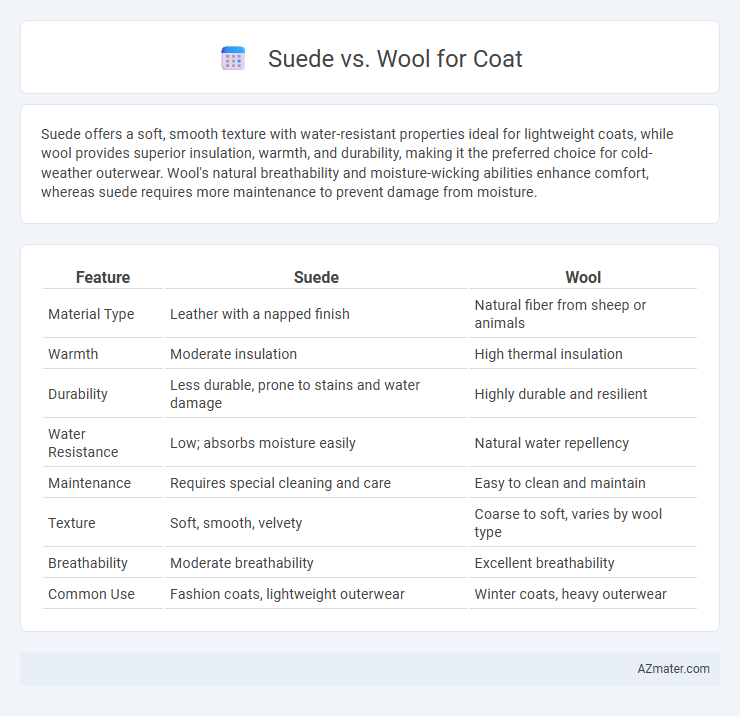Suede offers a soft, smooth texture with water-resistant properties ideal for lightweight coats, while wool provides superior insulation, warmth, and durability, making it the preferred choice for cold-weather outerwear. Wool's natural breathability and moisture-wicking abilities enhance comfort, whereas suede requires more maintenance to prevent damage from moisture.
Table of Comparison
| Feature | Suede | Wool |
|---|---|---|
| Material Type | Leather with a napped finish | Natural fiber from sheep or animals |
| Warmth | Moderate insulation | High thermal insulation |
| Durability | Less durable, prone to stains and water damage | Highly durable and resilient |
| Water Resistance | Low; absorbs moisture easily | Natural water repellency |
| Maintenance | Requires special cleaning and care | Easy to clean and maintain |
| Texture | Soft, smooth, velvety | Coarse to soft, varies by wool type |
| Breathability | Moderate breathability | Excellent breathability |
| Common Use | Fashion coats, lightweight outerwear | Winter coats, heavy outerwear |
Suede vs Wool: Introduction to Coat Fabrics
Suede and wool are two popular fabrics used in coat construction, each offering distinct benefits for style and functionality. Suede provides a soft, luxurious texture with a matte finish, ideal for sophisticated, lightweight coats suitable for mild weather conditions. Wool, known for its excellent insulation and durability, offers superior warmth and moisture resistance, making it a preferred choice for heavy-duty winter coats.
Key Characteristics of Suede and Wool
Suede features a soft, napped finish made from the underside of animal hides, offering a luxurious texture with moderate durability but less water resistance compared to other leathers. Wool provides excellent insulation, breathability, and natural moisture-wicking properties, making it highly effective for warmth and comfort in coats. Both materials vary in weight and texture, with wool often preferred for its resilience and thermal regulation, while suede is chosen for its stylish appearance and supple feel.
Warmth and Insulation: Which Keeps You Cozier?
Wool coats provide superior warmth and insulation due to their natural crimp, which traps air and retains body heat effectively. Suede, while stylish and wind-resistant, lacks the inherent insulating properties of wool, making it less effective in extreme cold. For optimal coziness in chilly conditions, wool remains the preferred material for maintaining consistent warmth.
Durability and Longevity: Suede or Wool?
Wool coats offer superior durability and longevity due to their natural resilience, moisture-wicking properties, and ability to retain shape over time. Suede, while stylish and soft, is more susceptible to staining, water damage, and wear, requiring more careful maintenance to preserve its appearance. Choosing wool ensures a longer-lasting coat with less frequent replacement, ideal for harsh weather and everyday use.
Comfort and Feel: Texture Comparison
Suede offers a soft, velvety texture that feels smooth and supple against the skin, providing a cozy and luxurious comfort ideal for mild to cool weather. Wool, on the other hand, features a naturally coarse yet flexible texture with excellent insulation properties, offering warmth and breathability that adapts well to varying temperatures. The tactile difference is significant: suede's plush surface appeals to those seeking softness, while wool's fibrous weave delivers a slightly rougher feel with unmatched heat retention.
Weather Resistance: Handling Rain and Wind
Suede, while stylish and soft, offers limited water resistance and can be easily damaged by rain, requiring careful treatment with water-repellent sprays to maintain durability. Wool naturally excels in weather resistance due to its dense fibers, providing excellent insulation and moisture-wicking properties that repel light rain and wind effectively. For harsh weather conditions, wool coats outperform suede by maintaining warmth and structural integrity without extensive waterproofing.
Maintenance and Care Requirements
Suede coats require delicate maintenance, including regular brushing with a suede brush and protection from water and stains using specialized sprays, as moisture can easily damage the nap and texture. Wool coats offer more straightforward care, often needing spot cleaning and occasional professional dry cleaning to maintain fiber integrity and shape. Proper storage, like using breathable garment bags and avoiding direct sunlight, is essential to preserve both suede and wool coat quality over time.
Style Versatility: Fashion Appeal of Suede vs Wool
Suede coats offer a sleek, luxurious texture that enhances casual and semi-formal outfits with a distinct, contemporary edge. Wool coats provide classic versatility, excelling in both formal and casual settings due to their timeless appearance and durability. The fashion appeal of suede suits trend-conscious wearers seeking softness and style variety, while wool remains the preferred choice for enduring elegance and adaptable layering.
Price and Value: Cost Considerations
Suede coats typically range between $150 and $400, offering stylish appeal but requiring more maintenance, while wool coats generally cost from $200 to $600, providing superior warmth and durability. Wool's natural insulating properties and longer lifespan often justify the higher initial investment, making it a cost-effective choice over time. Consumers seeking a balance between affordability and long-term value frequently favor wool for its resilience and classic appeal.
Choosing the Right Coat: Suede or Wool for Your Lifestyle
Suede coats offer a soft, luxurious texture ideal for fashion-forward wearers in mild climates, while wool coats provide superior insulation and durability suited for colder environments and active lifestyles. Wool's natural moisture-wicking and breathability support long-term comfort, making it a practical choice for everyday use, whereas suede requires more maintenance to protect against water damage. Selecting between suede and wool depends on balancing style preferences with climate needs and lifestyle activities to ensure both comfort and longevity.

Infographic: Suede vs Wool for Coat
 azmater.com
azmater.com